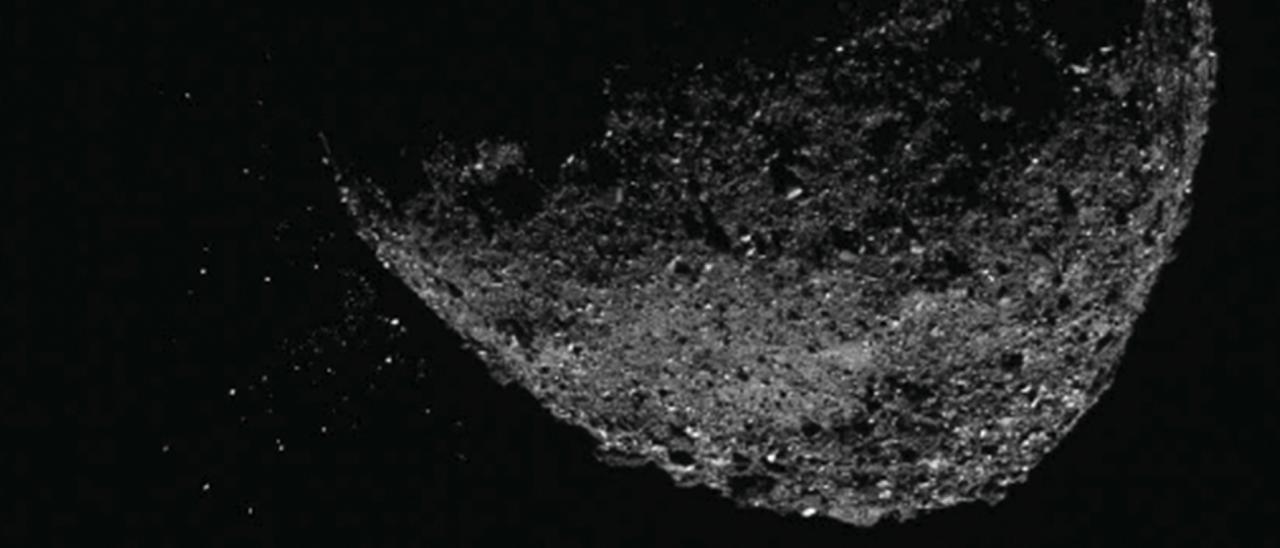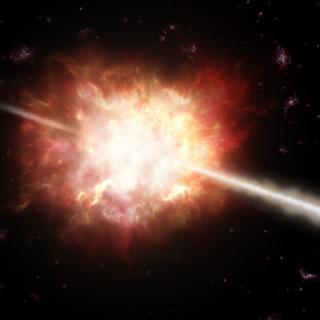CAPTION: Composite view of particle ejection from the surface of asteroid Bennu on January 6, 2019. This image was produced by combining two exposures taken by the NavCam 1 imager: a short exposure (1.4 ms) showing the asteroid followed by a longer exposure (5 s) to show the particles.
First results on the analysis of several particle ejection episodes imaged by the OSIRIS-REx spacecraft have been presented in a Science paper, co-authored by Julia de León and Javier Licandro of the Instituto de Astrofísica de Canarias (IAC).
NASA’s OSIRIS-REx spacecraft arrived at asteroid Bennu on December 2018. Only one week after entering orbit, in January 6, 2019, and only 4 days before Bennu’s closest approach to the Sun, the first particle ejection episode was detected in navigational images. Multiple events were subsequently detected between December 2018 and February 2019, with some of the largest events releasing dozens of observed particles. These events have been analysed in detail and the results have been presented today in a paper in the journal Science. Julia de León and Javier Licandro, researchers at the Instituto de Astrofísica de Canarias (IAC) and members of the OSIRIS-REx Image Processing Working Group, are among the authors of this publication.
“Active asteroids are objects that have typical asteroid orbits but show some kind of comet-like activity, either by developing a coma or a tail, or by the ejection of dust” says Javier Licandro. Several of these objects have been identified in the asteroid belt, some of them behaving like comets and ejecting dust during long periods of time, others observed to split into multiple objects or to disintegrate, or to show their activity in a series of impulsive events. “This is the first time we have observed activity on an asteroid at this low level” comments Julia de León. The three largest observed particle ejection events, on January 6, January 19, and February 11, released a total of 365 particles, of which 277 could be characterized. Particles were ejected with velocities ranging from 0.06 to 3.3 m/s and presented sizes from less than 1 cm up to 8 cm. “Including the three largest events, the mass loss from Bennu due to this ejection episodes was about 1 kg. This is just a minute fraction of Bennu’s total mass (730 million tons). As a comparison, active asteroid (3200) Phaethon losses between 10.000 and 100.000 kg of mass every time it makes a close passage to the Sun (perihelion passage)”, explains Julia de León.
A detailed analysis of the mechanisms that could potentially explain these ejection events has been also presented in this study. The most common mechanism for cometary activity, ice sublimation, was the least likely: temperatures on the surface of Bennu do not allow for the presence of the major cometary ice species in a stable phase. In addition, no water-ice absorption feature has been identified in the spectra of the surface of the asteroid, nor is their evidence for a coma or jets associated with volatile release. “Bennu’s surface experiences intense temperature variations over one rotation, which can cause cracks and fractures with time, that could be responsible for the ejection of particles” says Javier Licandro. Considering Bennu’s surface geology and composition, other plausible mechanisms include volatile release through dehydration of phyllosilicates, and meteoroid impacts. The finding of such low level activity on asteroid Bennu suggests that there is a continuum of mass loss event magnitudes among active asteroids.
Contacts:
Julia de León: jmlc [at] iac.es
Javier Licandro: jlicandr [at] iac.es
Artículo: D.S. Lauretta “Episodes of particle ejection from the surface of the active asteroid (101955) Bennu”, Science 06 Dec 2019: Vol. 366, Issue 6470, eaay3544.
DOI: http://dx.doi.org/10.1126/science.aay3544



